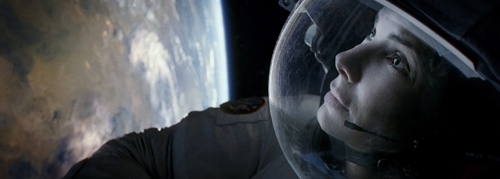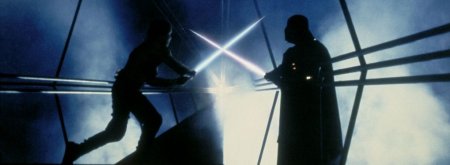Gravity - film review
Dr Ryan Stone (Sandra Bullock) was recruited for a space mission due to her technical expertise, not her experience as an astronaut. Nervous and jittery during a spacewalk, she's hardly reassured by the smooth patter of veteran Matt Kowalski (George Clooney), who's up there with her.
Then the unthinkable happens. Debris from a demolished Russian satellite comes hurtling towards them, and the two are cut loose both from the space station and from communications down below.
Letting Go
Spinning through the void, attached to one another only by a thin cord, survival seems impossible for Stone and Kowalski. Is there any way they can reach the distant Russian station, and find a way back down to Earth?

© Warner Bros. Pictures, 2013. Used by permission.
Earth From Above
Warning: This article contains plot spoilers
Gravity begins with an intensely slow, silent shot of the earth seen from space. Suspended against bottomless black the great 'blue marble' looks mesmerising and majestic. The reverential tranquillity is eventually interrupted by the faint sound of human chatter, and a space shuttle glides gracefully into view. As the camera moves closer, we see the astronauts busily working on its intricate technology. Having been astounded by natural beauty, we are now invited to marvel at the giant leaps in mankind's ingenuity.

© Warner Bros. Pictures, 2013. Used by permission.
However, space has not been entirely conquered, and the threat of danger still remains. Here the space walkers Kowalski and Stone are faced not with an alien enemy but with a series of unfortunate events. The nauseous Stone is horrified to learn that a cloud of space debris is hurtling towards them. Suddenly, mayhem is unleashed. The debris destroys the shuttle and, in a matter of moments, the results of humanity's great technological achievements are shattered.
Orbiting Inner Space
As the shuttle is torn to pieces, Stone is cast adrift into space. Her mind is thrown into complete and immediate panic. "What do I do? What do I do?", she screams. "I see nothing! I see nothing!" We view the world as Stone sees it, from within her claustrophobic and clammy helmet, where everything spins in sickening slow motion. So, having begun with a global view, we quickly zoom in on the reactions of a single individual. Against such a stark backdrop, Stone's mental anguish is thrown into sharp relief.

© Warner Bros. Pictures, 2013. Used by permission.
"Outer space", claims Cuarón, "is nothing but a metaphor for the inner space." The emptiness of the cosmos echoes Stone's inner emptiness. We learn that she has lost her daughter in a trivial accident and that her grief has caused her to retreat. She is, in Cuarón's words, "a victim of her own inertia". Every day of her life is now the same, she tells Kowalski: "All I do is go to work, and when I get home, I just drive."
Orbiting in her car, with only the radio for company, she wants to get as far away from tragedy as possible. Signing up for a space mission is merely the logical extension of her behaviour on earth, detaching herself from other people completely. When Kowalski asks her, "What do you like the most about this place?", her answer is immediate: "Silence". Adrift in space she is faced with the possibility of true silence. Suddenly, she is desperate for someone to speak to her, to hear her and to reach out to her. She, quite literally, needs something to hold on to.
Don't Let Go
Thankfully, Kowalski soon comes to retrieve her. "Grab something", he instructs her, "Grab anything." She clings on to him as he attaches their waists together with a cord. He then explains that they have only ninety minutes to save themselves - almost exactly the length of the film itself.

© Warner Bros. Pictures, 2013. Used by permission.
After a series of dramatic events, and with oxygen and power running low, Kowalski declares they will not both be able to make it. He decides to detach himself to give Stone a chance of surviving alone. She refuses to accept his offer of self-sacrifice, but staring her in the eye, Kowalski tells her, "You have to learn to let go." His message, of course, relates not only to their immediate predicament, but to her life as a whole. She needs to find a way to let go of her tragic past and to move on. In her moment of gravest need, Kowalski reaches out to her with truth and selfless love.
His final words to Stone, as he floats out into the darkness, are typical of his optimistic approach: "You should see the sun on the Ganges. It's amazing." Even in his dying moments, he is still in awe at the beauty of the world and the wonder of experiencing it. However, his words also contain a more transcendent message; the Ganges is the most sacred river for Hindus. As Kowalski floats towards his death, he looks at it and suddenly sees the light.
Learning to Pray
Stone feels differently about the spectre of her own death. Whilst on earth, she was barely living. Now, left alone in the ISS and faced with the possibility of her own demise, she seems resigned to it. The worst part, she tells herself, is that, "Nobody will mourn for me. Nobody will pray for my soul."

© Warner Bros. Pictures, 2013. Used by permission.
This sudden appeal to religion in her darkest moment comes as something of a surprise. Stone herself admits: "I'd say a prayer for myself [but] I've never said a prayer in my life. Nobody ever taught me how." The camera glances down to a holy card on the dashboard showing an image of St Christopher, the patron of travellers. Are any of the saints listening to her final words? Can God hear her too?
If so, she doesn't receive any answers. She decides to give up and turns off the oxygen. Then she experiences something mysterious. Is it a hallucination? A vision? A visitation? It reminds her of the love that she feels for her daughter, and persuades her that she must keep fighting to survive. "It's time to stop driving", she decides, "It's time to go home." With fresh motivation, she succeeds in reaching a Chinese space station, where she is able to enter an escape pod and propel herself towards earth.
Cosmic Rebirth
The film finds time for a lyrical moment while Stone is inside the ISS. Having shed her space suit, she is utterly vulnerable. In a balletic sequence, she allows her body to float weightlessly into the foetal position. She is the perfect image of an unborn child, cocooned in the control capsule with the cords forming the illusion of an umbilical cord. All she longs for is the familiar comforts of Mother Earth.
The same image is echoed as she crashes back down on earth into a lake. The camera pans to show a golden Buddah statue smiling down at her from the instrument panel. It is a clear signal that she is about to be reborn, to become a new version of herself. In the final moments of the film, Stone emerges from her womb-like capsule. She swims ashore, pulling herself up onto the muddy rocks which stain her hands and chest with smears of red. Then, gradually, she finds her feet and with shaky steps begins to walk.

© Warner Bros. Pictures, 2013. Used by permission.
Cuarón explains that the shot is not just about the birth - or rebirth - of an individual. It is also a metaphor for the birth of humanity itself:[1]
She's in these murky waters almost like an amniotic fluid or a primordial soup, in which you see amphibians swimming. She crawls out of the water, not unlike early creatures in evolution. And then she goes on all fours. And after going on all fours she's a bit curved until she is completely erect. It was the evolution of life in one, quick shot.
Having placed two feet solidly on the ground, the final words that Stone speaks are a simple, whispered, "Thank you". She has finally learnt to pray and it is a simple but profound prayer. She had come to value life, to be grateful for it and to embrace it.
The Journey to Understanding
Cuarón refused to give his film a neat resolution, but he explains that it does follow a conventional narrative arc: "I think rebirth in many ways is part of the journey for everybody, not only every human on Earth, but it's also the journey of great characters. Great characters in literature or in cinema they go through the stages of rebirth and of a new understanding."[2]
Stone herself is brought to a point of defencelessness that allows her to recognise the wonder of life on earth. Writing about the film, critics have pointed to several characters who undergo similar journeys of physical or metaphorical rebirth, including Odysseus, Orpheus, Osiris, Hermes and Christian from The Pilgrim's Progress. Perhaps most poignantly, Dante in his Divine Comedy literally descends into hell before finding his inner desires "turned like a wheel, all at one speed, by the Love which moves the sun and the other stars."
Dante's conclusion, like all of these stories, contains the implication that there is something beyond physical human reality. To find redemption beyond suffering, we need to acknowledge the existence of a spiritual realm which is more powerful and resilient than anything which man can create. In Gravity, the Ganges, St Christopher, Buddha and Stone's ghostly visitor are all indications of this transcendent possibility.

© Warner Bros. Pictures, 2013. Used by permission.
Whilst the film may not be committed to any single system of spirituality, it is hard to avoid the ways in which it echoes the Christian narrative. Paul Asay, writing in the Washington Post about great literary tales of rebirth, claims, "The most powerful ... of these stories is that of Jesus, who died and ... descended into hell, and rose again to bring us the possibility of new life."[3]
This is explained more fully in the Bible, where the apostle Paul writes:
When we were joined with Christ Jesus in baptism ... we died and were buried with [him]. And just as Christ was raised from the dead by the glorious power of the Father, now we also may live new lives. Since we have been united with him in his death, we will also be raised to life as he was. (Romans 6: 3-5)
This paradox is at the heart of the Christian faith - through death we find the possibility of rebirth.
For Stone, it is the sacrificial death of Kowalski that allows her to find the motivation to live again. The sacrifice that Christ offered on behalf of humanity was much greater - it defeated death forever and offered us the possibility of finding true communication and companionship. Perhaps, then, it is no accident that our world is governed by gravity, a force that pulls bodies together. Perhaps it is a reflection of its creator, who longs to draw us to himself "by the Love which moves the sun and the other stars".

© Warner Bros. Pictures, 2013. Used by permission.
Certificate: PG-13 (USA); 12A (UK) Contains sustained moderate threat, disturbing images and strong language
Questions for reflection
-
Why does Stone react to tragedy by withdrawing? What might cause us to isolate ourselves and what are the effects of this decision? What does the film have to say about the importance of being connected to other people? Does it have anything to say about the importance of being connected to God, or to the spiritual realm in general?
-
Why do you think that Kowalski decides to sacrifice himself for Stone's sake? In what ways - if any - were his actions Christ-like? Jesus teaches: "There is no greater love than to lay down one's life for one's friends." (John 15:13) Do you agree with this statement and why, or why not? Why does the idea of sacrificing yourself for others resonate so strongly in contemporary society?
-
Can you think of any other stories in which a character is 'reborn'? Why are these types of narratives so powerful and what makes us relate to them? In what way is Stone 'reborn' during the film, and how does this compare to the Bible's description of spiritual rebirth? You may want to read John 1:12-13.
Footnotes
[1] Meredith Woerner, 'Gravity's ending holds a deeper meaning, says Alfonso Cuaron', io9, 8 October 2013.
[2] Ibid.
[3] Paul Asay, In Gravity, finding spirituality in space, The Washington Post, 7 October 2013.
© 2013 Rachel Helen Smith



